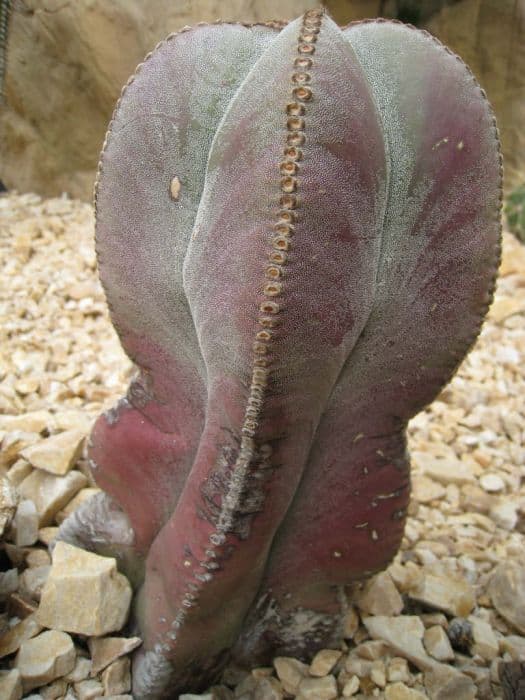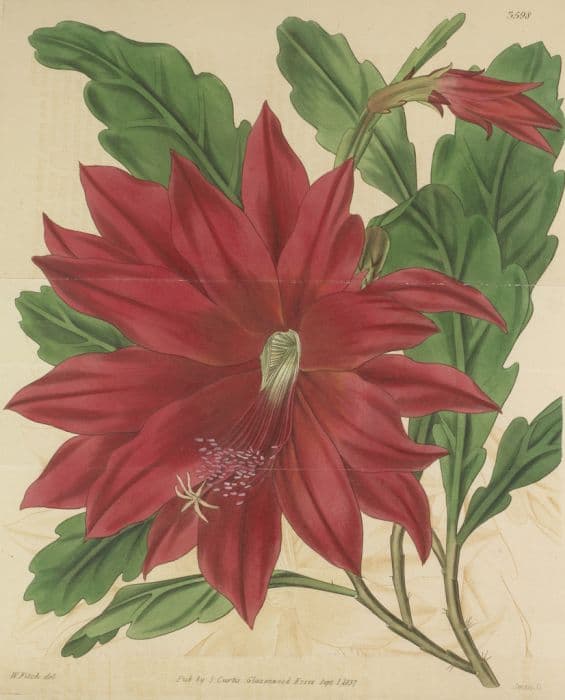Lace cactus Echinocereus reichenbachii

ABOUT
The Echinocereus reichenbachii, commonly known as the lace cactus, is a visually stunning plant known for its cylindrical shape and an appearance that can vary from a solitary stem to clusters of several tightly packed stems. The surface of these stems is lushly decorated with clusters of spines which can range in color from white to a golden hue, giving the cactus a halo-like appearance. This ornate spiny covering also serves as protection for the plant. During the blooming season, the lace cactus bursts forth with striking flowers. These vibrant blossoms are usually pink or magenta, a stark and beautiful contrast to the green of the stems and the paler spines. The flowers are funnel-shaped and can be quite showy, attracting pollinators like bees, birds, and bats. After the flowering period, the plant produces fruit that take on a greenish to reddish hue, further adding to the plant's visual appeal. Overall, the lace cactus presents a tough, hardy look that is both rugged and delicate due to its spiny exterior and lovely flowers, a desert beauty that is charming in its contradictions.
About this plant
 Names
NamesFamily
Cactaceae.
Synonyms
Lace Cactus, Lace Hedgehog Cactus, Purple Candle, Reichenbach's Hedgehog Cactus, Porcupine Hedgehog Cactus.
Common names
Cereus reichenbachii, Echinocereus pectinatus var. reichenbachii, Cereus pectinatus var. reichenbachii, Echinocereus baileyi, Echinocereus caespitosus, Echinocereus caespitosus var. baileyi, Echinocereus caespitosus var. reichenbachii, Echinocereus fitchii, Echinocereus reichenbachii var. albispinus, Echinocereus reichenbachii var. baileyi, Echinocereus reichenbachii var. bradleyi, Echinocereus reichenbachii var. caespitosus, Echinocereus reichenbachii var. fitchii, Echinocereus reichenbachii var. major, Echinocereus reichenbachii var. perbellus, Echinocereus reichenbachii var. reichenbachii.
 Toxicity
ToxicityTo humans
Lace Cactus (Echinocereus reichenbachii) is not known to be toxic to humans. Therefore, ingestion of this plant does not typically lead to poisoning or adverse health effects related to toxicity.
To pets
Lace Cactus is also not known to be toxic to pets. While ingestion of cactus parts, especially the spines, can cause physical injury or gastrointestinal upset, it does not typically result in poisoning or severe toxic reactions.
 Characteristics
CharacteristicsLife cycle
Perennials
Foliage type
Evergreen
Color of leaves
Green
Flower color
Pink
Height
0 feet 10 inches (25 cm)
Spread
0 feet 10 inches (25 cm)
Plant type
Cactus
Hardiness zones
5
Native area
North America
Benefits
 General Benefits
General Benefits- Aesthetic Appeal: Echinocereus reichenbachii, commonly known as Lace Cactus, adds visual interest to gardens and homes with its unique, ornamental spiky structure and vibrant flowers.
- Drought Tolerance: Lace Cactus is highly drought-tolerant, making it an ideal plant for xeriscaping and water-efficient landscaping, particularly in arid and semi-arid regions.
- Low Maintenance: This plant requires minimal care, thriving on neglect and making it suitable for busy or novice gardeners.
- Pollinator Attraction: The bright and showy flowers of the Lace Cactus attract bees, butterflies, and other pollinators, benefiting the local ecosystem.
- Easy Propagation: Echinocereus reichenbachii can be easily propagated from seeds or offsets, allowing gardeners to expand their collection or share with others.
- Longevity: Lace Cactus is a long-lived plant that can become a lasting part of a garden or indoor collection.
 Medical Properties
Medical PropertiesThis plant is not used for medical purposes.
 Air-purifying Qualities
Air-purifying QualitiesThis plant is not specifically known for air purifying qualities.
 Other Uses
Other Uses- Echinocereus reichenbachii, commonly known as Lace Cactus, can be used in xeriscaping and dry gardens due to its low water requirements.
- The Lace Cactus is often utilized in rock gardens to add texture and variety alongside other drought-tolerant plants.
- In miniature gardens or fairy gardens, the small size and interesting form of Echinocereus reichenbachii make it an enchanting addition.
- This cactus has been traditionally used as living fences in some regions to delineate property boundaries with its spiny exterior.
- The blooms of the Lace Cactus can be a valuable food source for pollinators like bees and hummingbirds in early spring.
- Photographers and artists may use Echinocereus reichenbachii as a subject to capture the beauty of desert flora.
- Educational use in schools for lessons on adaptation and survival strategies of plants in arid environments can involve this cactus.
- The structural and sculptural qualities of Lace Cactus make it an appealing element in modern and minimalist interior design.
- Seed harvest from the Lace Cactus fruit can be an educational activity for children to learn about plant life cycles and propagation.
- As part of a conservation effort, the Echinocereus reichenbachii can be cultivated to help restore degraded dryland ecosystems.
Interesting Facts
 Feng Shui
Feng ShuiThe Lace Cactus is not used in Feng Shui practice.
 Zodiac Sign Compitability
Zodiac Sign CompitabilityThe Lace Cactus is not used in astrology practice.
 Plant Symbolism
Plant Symbolism- Resilience: The Echinocereus reichenbachii, commonly known as Lace Cactus, often grows in harsh, rocky environments, symbolizing the ability to thrive under tough conditions.
- Protection: The spines of the Lace Cactus serve as a natural defense mechanism, representing protection and self-preservation.
- Beauty and Strength: Despite its sharp spines, the Lace Cactus produces beautiful flowers, symbolizing the combination of beauty and strength in one's character.
- Isolation: As a plant that often stands alone in the wild, the Lace Cactus can symbolize solitude or self-sufficiency.
- Adaptability: Lace Cactus's ability to store water and adapt to dry conditions is seen as a symbol of flexibility and the capacity to adjust to changing environments.
 Water
WaterThe Lace Cactus (Echinocereus reichenbachii) requires moderate watering. During active growth in spring and summer, water approximately every 7 to 10 days with enough water to soak the soil thoroughly until water runs out of the bottom of the pot; allow the top inch of soil to dry out between waterings. In the fall and winter, reduce watering to once a month, providing just enough to prevent the soil from completely drying out, not exceeding a few ounces. Over-watering can lead to root rot, so it's important to ensure the pot has good drainage.
 Light
LightLace Cactus thrives in bright sunlight. It prefers a south-facing window where it can receive direct sunlight for at least six hours per day. If grown outdoors, ensure it's placed in a spot that gets full sun exposure, mimicking its native desert habitat. Avoid low light conditions, as they can cause the cactus to weaken and grow unnaturally.
 Temperature
TemperatureLace Cactus can withstand a temperature range from 20°F to 100°F, making it quite hardy. However, it thrives best when the temperature stays between 70°F and 80°F. During the winter months, it's essential to protect the plant from frost, as temperatures below 20°F can be detrimental to its health.
 Pruning
PruningPruning Lace Cactus isn't typically necessary, as it maintains its shape well. However, if there are any dead or damaged spines, they can be gently brushed off. Always use caution when handling to avoid injury from the spines. The best time to remove any unwanted plant material is in the spring, just as the growth season begins.
 Cleaning
CleaningAs needed
 Soil
SoilLace Cactus thrives in a well-draining soil mix, preferably a combination of 50% mineral grit, such as coarse sand, pumice, or perlite, and 50% potting soil to provide some organic matter. The ideal soil pH for Lace Cactus is slightly acidic to neutral, ranging from 6.0 to 7.5. It's important that the soil allows for quick drainage to prevent root rot.
 Repotting
RepottingLace Cactus should be repotted every 2-3 years to refresh the soil and address any potential root crowding. Choose a pot that is slightly larger than the current one as Lace Cactus prefers a snug fit. When repotting, handle the cactus carefully and provide fresh soil mix to encourage continued health and growth.
 Humidity & Misting
Humidity & MistingLace Cactus prefers a dry environment with low humidity, typical of its native desert habitat. Indoor humidity levels should ideally range between 10% to 30%. Excessive humidity may increase the risk of fungal diseases, which the Lace Cactus is particularly susceptible to due to its preference for arid conditions.
 Suitable locations
Suitable locationsIndoor
Place Lace Cactus in bright, indirect light indoors for best growth.
Outdoor
Situate Lace Cactus in full sun to partial shade outdoors.
Hardiness zone
Lace Cactus is suitable for USDA zones 5-11.
 Life cycle
Life cycleEchinocereus reichenbachii, commonly known as lace hedgehog cactus, begins its life cycle as a seed that germinates in well-drained soil with warm temperatures and adequate moisture. Upon successful germination, a small seedling emerges and gradually develops into a young cactus with spiny ridges and a cylindrical shape. As it matures, the lace hedgehog cactus experiences vegetative growth, producing more stems and gaining girth; this stage can last for several years as the cactus slowly increases in size. Once mature, the plant produces vibrant pink to purple flowers in spring or early summer, only blooming for a short period. After pollination, often aided by bees and other insects, the cactus develops fruit that contains seeds, which eventually disperse to give rise to new cacti. Throughout its life, the plant may endure periods of dormancy, especially during cold or dry seasons, preserving resources until favorable conditions return.
 Propogation
PropogationPropogation time
Spring-Early Summer
The most popular method of propagation for Echinocereus reichenbachii, commonly known as Lace Cactus or Hedgehog Cactus, is through seed sowing. Seeds can be sown in spring or summer when temperatures are warm enough to encourage germination—typically a consistent 70°F (21°C) or higher. The seeds should be lightly covered with a fine layer of sand or a well-draining soil mix and kept moist until germination occurs, which usually takes between 14 and 30 days. Once the seedlings have developed a few sets of true spines and have sufficiently hardened off, they can be carefully transplanted into individual pots. It is important to provide plenty of light and a steady, but moderate, watering regimen as they continue to grow.








